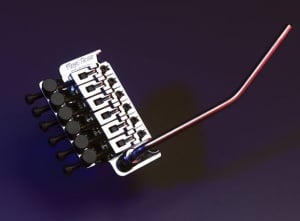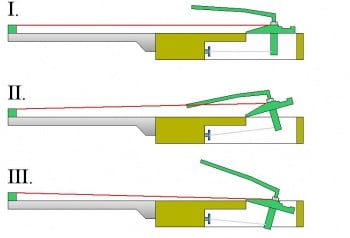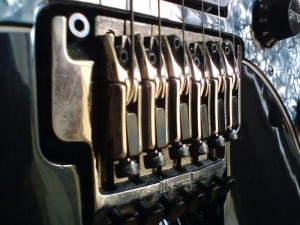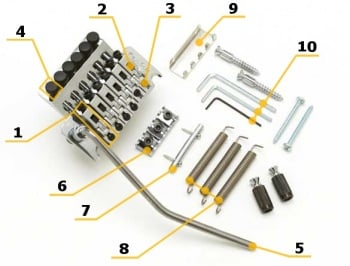Floyd Rose
The Floyd Rose tremolo system is a system that allows you to raise your pitch with the whammy bar. On the classic tremolo systems, tone lowering was the only possibility. Floyd Rose is the name of the organization that licenses and disitributes the Floyd Rose Locking Tremolo. A full Floyd Rose system consists of a floating bridge with locks to prevent the strings from detuning and a lock at the nut of the fret board to hold the strings and again to prevent from detuning. Because of the locks, the tuning pegs don’t work anymore, so they have made heads for fine tuning. The Floyd Rose Tremolo was the first tremolo to be able to lower and raise the pitch.
Contents |
History
Floyd D. Rose was a amateur guitarist and worked as a machinist on jewel inlays. He was influenced by the more aggressive players like Ritchie Blackmore and Jimi Hendrix. In the late seventies he was not happy with classic tremolo he had, which could only drop the pitch. This is why he used his engineering skills to improve his own Gibson Les Paul. He got himself a prototype of his tremolo and installed in on the Les Paul
Mr. Rose rented the equipment he needed to make more prototypes and he showed them to Randy Hansen. Mr. Hansen was very pleased with his invention and was amazed by the stability of the tuning. The popularity of this tremolo started to grow. After he got more and more orders, he bought his own manufacturing equipment and started a little “factory” in his basement. A guitar magazine published an article about the Floyd Rose system and the tremolo even became more popular. On the third of January, 1977 Floyd Rose filed his first US patent application, which was issued a small three years later in October 1979. Floyd even got a acquaintance of emerging guitar player [Eddie Van Halen]], who liked the new bridge and was a big promoter of the product. Later also Steve Vai started to use the tremolo system together with plenty of other guitarists.
How it works
The Floyd Rose Tremolo systems contains of several parts to do it’s job. When the tremolo bar is not touched, the bridge floats. Floating means that it’s free to move up or down. This is possilbe because there is tension on the bridge on both sides, and they are both equal. The strings pull the bridge towards the nut, and the springs in the back of the guitar pull the bridge own, away from the nut. The locking units make sure the strings don’t detune. The nut lock stops the strings from slipping of the tuning peg, and the bridge locks stop the strings from slipping on the bridge side.
When you push the bar down, the bridge will angle towards the nut. The stringstension will get lower and the pitch will sound lower as well. This can be used for a divebomb or whammy harmonics (more explanation on that in the harmonics section. When the bar is in that position, the springs in the back of the guitar pulls the bridge back, so when you release the tremolo, the bridge will float again. This movement detunes the strings on classic tremolo systems because the string’s tension is removed for a while and stretched up again, resulting in a more stretched string. The Floyd Rose System locks the string at the nut and at the bridge, so the strings can’t stretch any further, making it harder to detune.
When you lift the bar, the opposite happens. The string tension gets higher and the spring tension lowers. Again, the bridge will float again after the bar is released, this time because of the high string tension pulling the bridge back in position. The strings, again, won’t detune because the can’t slip of the tuning pegs when the tension rises. The double locking system takes care of it. This movement rises the pitch, because the string tension gets higher.
A thing to note with these movements is that the action changes as well when the bar is held up or pushed down. In the picture, this can be seen very clearly. In position I the action is at the standard height. When the bar is pushed down, like in position II, the action increases, leading to uncomfortable playing. Also the low string tension can give buzzing strings, because they hit the frets. In position II the pitch rises, and the action lowers. This can also produce string buzzes, again with the same reason as before; the strings hit the frets. Another thing is that the strings all are affected differently , but also simultaneously. The lower strings are less effected by the tremolo, then the higher ones. This gives problems with playing in tune. This is why often the guitarist only let’s three or two strings ring out. Last point is prety obvious. When the strings tension keeps being raised and lowered over and over again, the chances at string breakage grow.
Varieties of the locking tremolo
Ofcourse, other brands saw the trick and tried to make several other types of locking tremolo’s. Here’s a little list.
Floyd Rose Original: This is the oldest model, and the one that Floyd D. Rose orginaly invented. Most models produced after 1977 had almost the same name as this one, only they didn’t have Original after their name. This version doesn’t have finetuners, but is double locked, giving a big tuning and intonation problem.
Floyd Rose II: This is a sort of low end version of the Original Floyd, it was mostly used on the cheaper instruments. The early vesions were singe locked, but later they were double locked. The diffrence was mainly in the materials.
Floyd Rose Licensed: These are all version that were made by other manufacturers, but with license from Floyd Rose. These models all look very similar to the original Floyd Rose version, but most of them are tweaked to get some more cost efficiency. Most of these version were reliable and the most known producing brands are Schaller and Gotoh.
Yamaha Finger Clamp: This one lookes very much like the Floyd Rose Tremolo’s, the only diffrence is that they have built in levers, so you don’t need allen keys to finetune the guitar.
Ibanez Edge is Ibanez’s version of the Floyd Rose. They are five version from this tremolo including a pro version. The Edge III and the Edge pro are seen as more derived models, and therefore aren’t called Floyd Roses. The Ibanez Zero Resistance is also a veriant, it uses ball-bearing mechanics to give the tremolo more consistency. Even with heavy abuse of the tremolo, this one should stay prety much in tune. The Ibanez Fixed Edge is a bit of an outsider. This one is not a tremolo, but only uses the locks to keep the strings in tune. This one is mounted on the body, and meant to give hard tail guitars a better consistency.
Fender Deluxe Locking Tremolo: this piece of engineering was specially designed by Fender Musical Instruments Corporation in conjuction with Floyd Rose himself. They used locking tuners, a modified Fender 2-point synchronized tremolo with locking bridge saddles and a special low-friction LSR roller Nut which allows strings to slide through the nut during tremolo use. This is a dooble locking system, only the other locking point is at the tuner instead of at the nut..
Floyd Rose 7-string: A redesign of the Original for 7-string guitars. Everything is prety much the same.
Floyd Rose Pro: This is a low-profile version of the Original. The tremolo design is changed in a way that the guitarist will have less problems when he moves his arm to the tremolo. The bridge has narrower string spacing. The finetuners are angled for more comfortable playing.
Floyd Rose Speedloader Tremolo: A redesign introduced around 2003. It combines the Floyd Rose Orignial with a speedloader system to get a new design. This new design got rid of many disadvantages of the original Floyd Rose Locking Tremolo design, but requires special strings.
Parts
Floyd Rose Tremolo’s are well known for their good service. Everything is well documented and most parts can be purchased via internet. These are the parts that are on most of the Floyd Rose type Termolo’s:
Floyd Rose tremolos are known for their excellent serviceability: the mechanism is well-documented and spare parts can be purchased directly from manufacturer or via dealers. Usually, Floyd Rose device (as Floyd Rose Pro Tremolo on the image) consists of these parts:
1. Saddle: A metal box the string is locked into. There is one saddle for each string, hence six for the standard 6-string guitars, and seven for 7-string guitars. Each saddle contains a long screw that fixes the string holder block inside it. An Allen wrench is required to loosen or tighten these.
2. String Holder Block or Saddle Block : A cube-shaped metal block that presses the string end into the saddle wall to lock it tight.
3. Intonation Screws: Screws that kep the saddles in place. Driving these screws in or out of the saddle leads to a intonation difference. Again an Allen wrench is needed.
4. Fine Tuners: Screws that are used to fine-tune strings instead of the machine heads which cannot be used after the nut has locked the strings at the neck. It can be rotated with bare hands.
5. Tremolo Arm: The most visible part of mechanism, a handle that can be used to change played notes pitch up and down during play. This is also called the tremolo or whammy bar.
6. Nut: A string clamp, on the place of the “zero fret”. It has screws and braces called locks, to lock the strings tight.
7. String Retainer: A metal bar installed at headstock to retain strings that go to the machine heads.
8. Springs: Springs are in the back of the guitar to pull the bridge into a floating position. There are usually 3 springs, but this can be adjusted to the players wish. Some guitars have just one spring and others have 5.
9. Spring Claw Hook: A connector between the guitar body and springs. It has special "claws" to attach the springs to. This part is usually mounted to the guitar body using loose long screws that can also be used to change the tension of springs and thus re-balance the whole tremolo system.
10. Allen wrenches: Three sizes are usually supplied with the tremolo. The smallest is used for intonation screws; the mid-sized wrench is used for fixing screws on saddle blocks and the largest is for nut screws. This is also a nice example of the cost efficiency with Floyd Rose licensed tremolo, they only supply the customer with two wrenches and they make the screws on the saddle blocks and the nut the same.
Setting up a Floyd Rose
The setup with Floyd Rose guitars is a bit harder then it is with other types of tremolos. This is due the locks. They make everything a bit more time consuming. To remove a string, the nut lock must be released with an allen wrench first. Then the loose string can be unlocked at the bridge, again with an allen wrench. Then the string can be removed. To place a new string on the guitar, the ball end has to be cut of the string, or the string must be inserted backwards, leaving the ball in the tuning system. Then first lock the bridge and then lock the nut locks. The new Edge Pro’s on some Ibanez guitars, like the JEM, JS and RG series, have the advantage of not having to cut the ball ends. It’s possible to loosen a top slinding string block so you can put the strings in from the top. This saves a lot of time.Some models have different ways to do this. E.g. the Yamaha Floyd Rose Licensed tremolo has build-in cranks, so you don’t need all the allen wrenches.
Popular users
The tremolo system was being popularizes by Richie Sambora, Dave Murray, Adrian Smith (from Iron Maiden ), Vinnie Vincent and Eddie van Halen. Most modern guitar players use the Floyd Rose system in the more heavy metal. Also a lot of guitarists use the whammy bar as a tool to make new sounds. For instance Joe Satriani, or Satch, uses his tremolo, which is an EdgeIII or EdgePro, to raise the pitch of a pinch harmonics to get his “Satch Scream”. Dimebag Darrel made use of his bar to make “Dime Squeals” and Tom Morello uses his whammy in combination with several other effects to make Hip Hop like sounds. Herman Li, who is the guitarist of dragonforce uses an Edge-Zero, a derived from the original Floyd Rose, just like Satch.
Patents:
Floyd D. Rose holds several patents for his bridge design:
US4,171,661 (1979-10-23) Floyd D. Rose Guitar tremolo method and apparatus — bridge mechanism patent.
US4,497,236 (1985-02-05) Floyd D. Rose Apparatus for restraining and fine tuning the strings of a musical instrument, particularly guitars — first fine tuners and saddle patent
US4,549,461 (1985-10-29) Floyd D. Rose Apparatus for restraining and fine tuning the strings of a musical instrument, particularly guitars — second fine tuners and saddle patent
US4,555,970 (1985-12-03) Floyd D. Rose Tremolo apparatus capable of increasing tension on the strings of a musical instrument — spring and claw mechanism
US4,882,967 (1989-11-28) Floyd D. Rose Tremolo apparatus having broken string compensation feature — early patent for a tremstopper device
US4,967,631 (1990-11-06) Floyd D. Rose Tremolo and tuning apparatus — patent for Floyd Rose Pro, low-profile version











